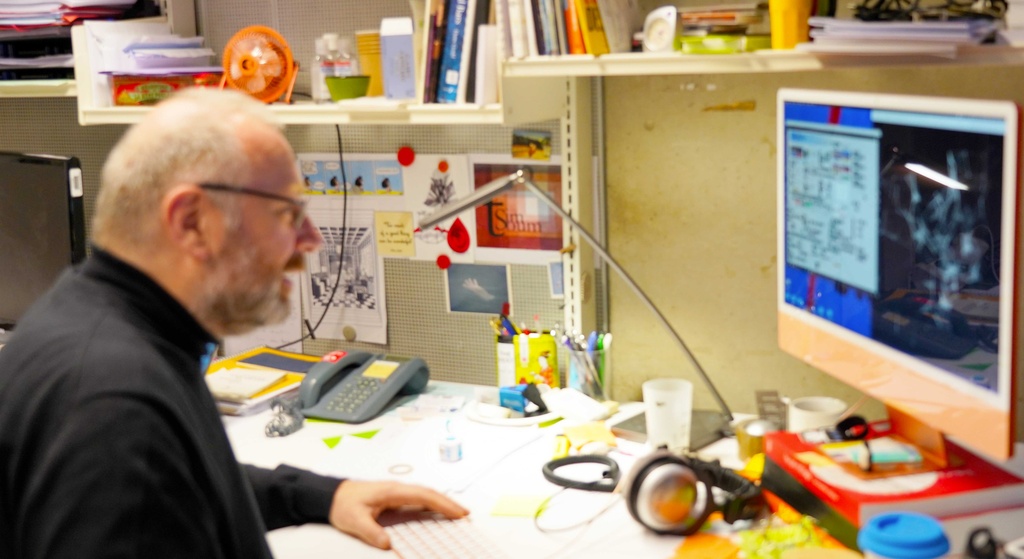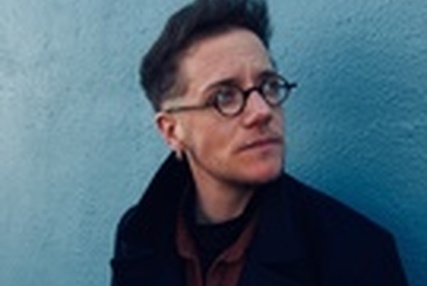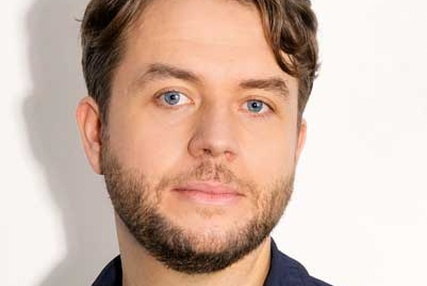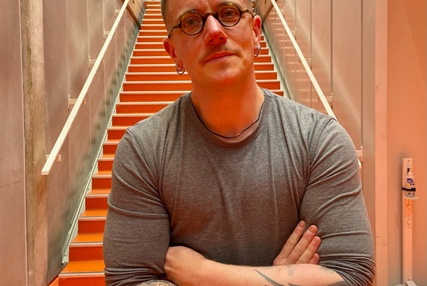Directeur de recherche CNRS au sein de l’équipe Représentations musicales depuis 2011, Jean-Louis Giavitto a accompagné, et accompagne encore Sasha J. Blondeau. Il détaille pour nous les contributions de l’équipe au travail du jeune compositeur.
Avant d’évoquer votre implication dans la résidence en recherche artistique de Sasha J. Blondeau, pourriez-vous nous exposer vos objets d’études ?
Mon travail de recherche porte sur les langages de programmation et plus particulièrement sur les représentations et l’usage du temps dans ces langages. Avant de rejoindre l’Ircam, j’ai travaillé avec des biologistes sur la modélisation et la simulation de processus de morphogenèse : comment une forme se construit dans le temps et se déploie dans l’espace. Même si la biologie du développement peut sembler loin de la musique, ces thèmes sont communs et plusieurs notions que j’ai développées pour simplifier la simulation de processus de morphogenèse entrent en résonance avec les besoins des compositeurs.
Comment vos activités de recherche se sont-elles développées au sein de l’équipe Représentations musicales ?
Quand je suis arrivé à l’Ircam en 2011, Arshia Cont développait le projet Antescofo. Son idée était de coupler une machine d’écoute (capable de déterminer, à partir du flux audio, où un musicien en est rendu dans une partition) avec un langage de programmation dédié à l’écriture des sons électroniques.
L’objectif est de retrouver, dans le cadre de la musique mixte, la liberté interprétative du musicien en synchronisant en temps réel les sons électroniques avec les fluctuations du jeu humain.
J’ai rejoint tout naturellement le projet où j’ai développé la partie langage, en interaction avec des compositeurs, dont Sasha J. Blondeau.Les langages de programmation dédiés à la musique se répartissent en deux classes selon qu’ils adressent la production du son ou qu’ils visent la partition. MUSIC-N, Max ou PureData sont du côté du son et utilisés en concert, tandis qu’OpenMusic, un environnement de programmation visuelle et un système de composition assistée par ordinateur (CAO), est du côté de la partition – utilisé par le compositeur au cours de l’écriture musicale. Antescofo dépasse cette dichotomie : le compositeur l’utilise pour écrire les parties électroniques en lien avec la partition de l’instrumentiste et le système est aussi présent lors du concert pour écouter la performance et contrôler, en plein accord, la production des sons électroniques. Il est ainsi possible de lier des problématiques de composition et d’interprétation, de matériau musical et de forme.
Faut-il donc que les compositeurs désireux de faire de la musique électronique apprennent à programmer ?
Marco Stroppa a développé dans plusieurs interventions l’idée selon laquelle les langages de programmation offrent un espace de pensée extrêmement puissant, lui permettant de construire et de travailler l’ontologie musicale qu’il développe pour une pièce. Cette ontologie se réfère à la structure conceptuelle, aux entités, aux relations et aux règles qui définissent les objets musicaux dans son travail. Ce n’est pas le développement du code nécessaire pour réaliser des traitements audios plus ou moins complexes qu’il vise, mais l’effort de modélisation nécessaire pour concevoir ses objets musicaux et leurs relations de manière précise à travers l’architecture des programmes qui accompagnent son écriture.
C’est un point de vue auquel j’adhère complètement. Et, plutôt que de voir le compositeur se plier aux contraintes informatiques, je préfère voir l’informatique se conformer à la nature propre du langage musical. Concevoir un langage dédié (les Anglais parlent de DSL : domain-specific language) exige de comprendre les entités du domaine d’application et les opérations qui s’y appliquent. Il faut tenter de « parler le langage de la tribu » comme disait Claude Lévi-Strauss, en se refrénant de parler à la place des autres (je ne suis pas compositeur) mais en apportant ses compétences propres (l’outil informatique).

Jean Louis Giavitto à l'Ircam © Ircam-Centre Pompidou
Sasha J. Blondeau a fait sa thèse au sein de l’équipe entre 2014 et 2017 : de quelle manière vous, et le reste de l’équipe, avez nourri son travail ?
J’avais travaillé sur des représentations topologiques pour la représentation de connaissances.
L’intuition qui me guidait était que la topologie (avec ses notions de voisinage, de chemin, d’obstruction, de contact…), offrait une matière pertinente pour cela, un lien entre deux entités pouvant se représenter par un voisinage au sein d’un espace abstrait.
J’avais utilisé cette approche plus d’une dizaine d’années avant de rencontrer Sasha, pour l’analyse des contes de fées. J’avais offert à mon neveu un livre de Warja Lavater qui raconte l’histoire du Petit Chaperon rouge, mais sous une forme visuelle complètement abstraite. Le petit chaperon rouge y est figuré par un rond rouge, le loup par un rond noir, la forêt par une multitude de points verts… Et l’histoire est contée via des agencements visuels, sans un seul mot, de manière pourtant totalement intelligible, ce qui m’avait étonné. J’avais demandé à mon neveu comment il reconnaissait le petit chaperon rouge dans la suite des illustrations abstraites. Il m’avait répondu qu’il y a une légende en quatrième de couverture qui, comme une carte géographique, associe les « symboles » aux personnages et aux objets. Pourtant, sans même avoir consulté la légende, il m’apparaissait clairement que ce que j’avais sous les yeux était le bien l’histoire du Petit Chaperon rouge et pas celle de Pierre et le Loup.C’est en essayant de comprendre pourquoi, que ces représentations topologiques ont émergé : l’analyse des co-occurences (ce qui apparaît ensemble ou, au contraire, ce qui n’apparaît jamais ensemble) permet de définir automatiquement des structures topologiques (techniquement : des complexes simpliciaux abstraits [1]) qui correspondent à une « signature » de l’histoire. Et la signature de Pierre et le Loup n’est pas la signature du Petit Chaperon rouge. Alors que la signature du livre de Warja est très similaire à la signature du conte de Charles Perrault.
Comment avez-vous imaginé ensemble ce modèle ? Pourquoi, par exemple, ce choix des tétraèdres et de répartition dans l’espace ?
Sasha est arrivé avec des préoccupations liées à l’atlas Mnémosyne d’Aby Warburg. Historien de l’art, Warburg accumule à partir de l’année 1900 plus de 60 000 volumes. Cette bibliothèque, et son système singulier de classement, constitue son Denkraum, son espace de pensée.Les livres ne sont classés ni chronologiquement ni alphabétiquement, mais selon une relation « de bon voisinage ». Cette proxémie détermine le rangement du fond et des nouvelles acquisitions : chaque livre doit répondre à une question posée par un de ses voisins, et poser lui-même une question. Le résultat met en scène, au niveau de la bibliothèque dans sa globalité, un espace labyrinthique qui rend compte, de façon visible dans la disposition spatiale des collections, de la variété des catégorisations du savoir, de leurs organisations évolutives, et d’une épistémologie en réseau. Cette disposition des livres dans l’espace, dynamique et se réarrangeant selon les projets de son propriétaire, permet des rencontres inopinées, des connexions inattendues, des liens disparates réalisant physiquement, à travers les rayonnages, une immense mémoire associative, « une machine qui aide à penser, une machine avec laquelle penser, une machine à laquelle penser[2] ».
Vous parliez à l’instant de « complexes simpliciaux » : de quels objets mathématiques vous êtes-vous servis (ou inspirés) et comment, si c’est le cas, ces outils servent-ils dans le cadre de ce travail formel ?
De la rencontre de ces deux intuitions est né le sentiment que les idées musicales d’une pièce pouvaient aussi donner lieu à un espace, une carte que l’on peut parcourir. Ce sentiment s’est précisé au fil du développement des outils permettant de représenter visuellement ces espaces abstraits en construisant automatiquement une représentation visuelle (limitée à 3 dimensions) à partir d’une description symbolique.
Sasha a soutenu sa thèse en 2017. Qu’est-ce qui vous amène à reconduire la collaboration, six ans après, dans le cadre de cette résidence en recherche artistique ?
La résidence proposée par Sasha me permet d’écouter les compositeurs parler de forme, et d’imaginer de nouvelles constructions permettant de rendre compte explicitement de cette partie du travail de composition. On est encore loin de proposer de nouvelles représentations permettant d’outiller et d’assister le travail sur la forme musicale. Mais, à terme, l’idée est, par exemple, de renforcer le pont permis par Antescofo entre son et forme par de nouvelles constructions facilitant le travail de composition et sa transmission.
Quel type de pont permet justement Antescofo entre son et forme ?
Par exemple, une des motivations musicales de ces « cartes » est, pour Sasha, de réfléchir et de représenter explicitement les relations entre matériau et forme. La morphologie ou les caractéristiques d’un son (qui s’évaluent sur des échelles de temps relativement courtes, de l’ordre de la seconde), soulignent, contredisent ou accompagnent-elles une forme caractérisée par une évolution sur des durées plus longues (geste, phrase, développement musical) ? Cette problématique est constamment à l’œuvre dans une partition Antescofo, notamment lorsqu’il s’agit de contrôler une synthèse sonore en lien avec le déroulement musical.
De manière plus générale, quel lien entre Antescofo et le modèle imaginé ?
Les structures de contrôle écrites en Antescofo, au sens d’un langage de programmation (par exemple : répétition, processus, mise en séquence ou, à l’inverse, juxtaposition parallèle), sont les outils fournis au compositeur pour décrire précisément un déroulement musical. Existe-t-il des structures plus pertinentes et mieux adaptées à l’écriture compositionnelle, susceptibles d’être offertes au compositeur ?
Si on prend encore un peu de recul : qu’attend l’équipe de cette résidence en recherche artistique ?
Les attentes sont doubles. Du côté musical, nous aimerions détecter des points de contacts entre les différentes approches des compositeurs quand ils abordent les problématiques de forme. La motivation n’est pas de prétendre trouver un modèle qui engloberait toutes les pratiques et tous les styles, mais de repérer, derrière les idiosyncrasies, des problématiques ou des approches communes.
Du côté informatique, comme évoqué à l’instant, nous espérons que ces problématiques pourront être outillées et, à terme, offrir des structures de contrôles plus naturelles et plus adaptées à l’écriture musicale.
Enfin, comment cette résidence s’inscrit-elle dans les activités de l’équipe ?
Je suis dans une équipe de recherche qui s’appelle « Représentations musicales». Les thématiques évoqués sont donc centrales dans l’équipe. À un niveau plus personnel, cette résidence me permet de familiariser plus avant avec « le langage de la tribu ».
![]()
Propos recueillis par Jérémie Szpirglas
[1] En mathématiques, un complexe simplicial est un objet géométrique déterminé par une donnée combinatoire et permettant de décrire certains espaces topologiques en généralisant la notion de triangulation d'une surface.
[2] Carlo Ginzburg. Une machine à penser. Common Knowledge, 18(1) :79 – 85, 2012.





